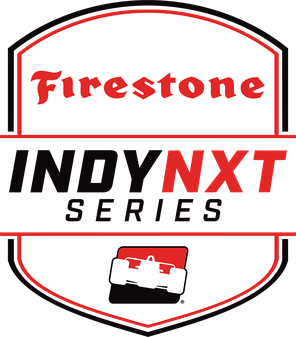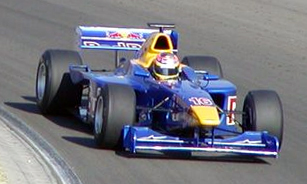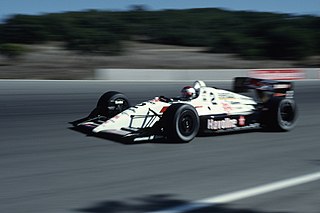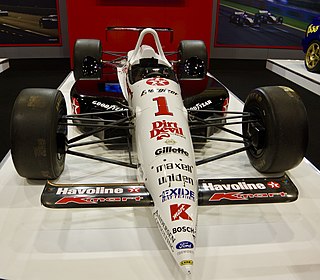
Robert Buddy Lazier is an American auto racing driver, best known for winning the 1996 Indianapolis 500 and the 2000 Indy Racing League season championship.

Indy NXT, previously Indy Lights, is an American developmental automobile racing series sanctioned by IndyCar, currently known as INDY NXT by Firestone for sponsorship reasons. Indy NXT is the highest step on the Road to Indy, a program of racing series leading up to the IndyCar Series.

Scott Everts Brayton was an American race car driver on the American open-wheel circuit. He competed in 14 Indianapolis 500s, beginning with the 1981 event. Brayton was killed in practice after qualifying in pole position for the 1996 race.

The 1996 Indy Racing League was the first season in the history of the series, which was created and announced on March 11, 1994 by the Indianapolis Motor Speedway, as a supplementary Indy-car series to the established Indy Car World Series sanctioned by Championship Auto Racing Teams (CART) since 1979. It consisted of only three races, as the season concluded with the 80th Indianapolis 500 in May. Walt Disney World Speedway was completed in time to host the first ever event of the Indy Racing League (IRL), and Phoenix International Raceway switched alliances from CART to the IRL, in order to host the second event of the season. At the conclusion of the three-race schedule, Scott Sharp and Buzz Calkins ended up tied for first place in the season championship. With no tiebreaker rule in place, the two drivers were declared co-champions. Its creation, and the opposition of Indy Car's teams and drivers to take part in it, marked the start of 'the Split', a 12-year period of competition between rival series at the top level of American Open Wheel racing that had lasting negative effects in the sport.

Formula 3000 (F3000) was a type of open wheel, single seater formula racing, occupying the tier immediately below Formula One and above Formula Three. It was so named because the cars were powered by 3.0 L engines.
The American Indycar Series (AIS) was an American open wheel racing series founded in 1988 by Bill Tempero. It utilized used chassis and engines from the CART series and the Indy Racing League. CART and IRL drivers Buddy Lazier, Jaques Lazier, Robby Unser, and Johnny Unser found success in the AIS.

The Buick Indy V6 engine is a powerful turbocharged, 3.0–3.4 L (180–210 cu in), V-6, Indy car racing internal combustion engine, designed and produced by Buick for use in the CART PPG Indy Car World Series, and later the IRL IndyCar Series; between 1982 and 1997. It shares the same architecture, and mechanical design, and is based on the Buick V6 road car engine. A slightly destroked 3.0-liter V6 engine was also used in the March 85G and March 86G IMSA GTP sports prototypes.
The Oldsmobile Aurora Indy V8 engine is a 3.5-liter to 4.0-liter, naturally-aspirated, V-8 Indy car racing engine, designed, developed and produced by Oldsmobile, for use in the IRL IndyCar Series; from 1996 to 2001. It is a variant of the Northstar engine.
The Mercedes-Benz Indy V8 engine, known as the Ilmor 265-D (1994), and later the Mercedes-Benz IC108 (1995-2000), is a powerful, turbocharged, 2.65-liter, Indy car racing V-8 engine, specially designed, developed, and built by Ilmor, in partnership and collaboration with Mercedes-Benz, to compete in the CART series; between 1994 and 2000.
The Menard engine was a modified Buick V6 engine designed for the newly formed Indy Racing League by John Menard, the owner of Team Menard. The engine only lasted through 1996, the IRL's only season without its own unique chassis and engine combination. Before being used in the IRL, the Menard engine was used almost exclusively in the Indianapolis 500, with its first appearance being in the 1993 race. Menard engines powered many future IRL drivers such as Scott Brayton, Eddie Cheever Jr., Arie Luyendyk, and Buddy Lazier in various Indianapolis 500s before the IRL was conceived.

The Lola T93/00 is a highly successful open-wheel racing car chassis, designed and built by Lola Cars that competed in the CART open-wheel racing series, for competition in the 1993 season. It was extremely competitive, winning 8 races that season, including a win for rookie Nigel Mansell on debut in Australia. It also gave teammate Mario Andretti a win, as well as giving Al Unser Jr. and Danny Sullivan a win each. It was mainly powered by the 800–850 hp (600–630 kW) Ford/Cosworth XB turbo engine. It powered Nigel Mansell to his maiden first and only IndyCar World Championship.

The Lola T90/00 is a highly successful open-wheel racing car chassis, designed and built by Lola Cars that competed in the CART open-wheel racing series, for competition in the 1990 season. It was extremely competitive, winning a total of 12 races that season, including a win for Dutchman Arie Luyendyk at the prestigious Indianapolis 500. It also gave American Al Unser Jr. his first of two IndyCar World Championships, with Galles-Kraco Racing. It was powered by the 735–800 hp (548–597 kW) Ilmor-Chevrolet 265-A turbo engine.

The Lola T91/00 is a highly successful open-wheel racing car chassis, designed and built by Lola Cars that competed in the CART open-wheel racing series, for competition in the 1991 IndyCar season. It was the most dominant car that season, and extremely competitive, winning a total of 14 out of the 17 races during the 1991 season, with Michael Andretti enjoying the most considerable success, scoring 8 wins, taking 8 pole positions, and leading more laps than any other driver that season. Al Unser Jr. and Arie Luyendyk scored 2 wins, while Bobby Rahal and John Andretti scored one win each. Even though Bobby Rahal won only one race, he had 11 podium finishes, and 13 top 10s, making him a very serious challenger and competitor for the title that year. Michael Andretti eventually went on to win the 1991 IndyCar World Drivers' Championship with this car. It was powered by the 720–800 hp (540–600 kW) Ilmor-Chevrolet 265-A turbo engine.
The Lola T92/00 is a highly successful open-wheel racing car chassis, designed and built by Lola Cars that competed in the CART open-wheel racing series, for competition in the 1992 IndyCar season. It was extremely competitive, winning 10 out of the 16 races that season, and clinching 14 total pole positions, including the opening round in Australia, and the special Marlboro Challenge event at Nazareth. It was mainly powered by the 800–850 hp (600–630 kW) Ford/Cosworth XB turbo engine, but some also used the Ilmor-Chevrolet 265-A V8 turbo engine, or the Buick Indy V6 turbo engine with this chassis. It powered Bobby Rahal to his third and final IndyCar World Drivers' Championship.

The Lola T94/00 is an open-wheel racing car chassis, designed and built by Lola Cars that competed in the CART open-wheel racing series, for competition in the 1994 IndyCar season. It wasn't as competitive as its predecessors, only managing to score one win, with Scott Goodyear at the Marlboro 500 in Michigan It was mainly powered by the 800–850 hp (600–630 kW) Ford/Cosworth XB turbo engine, but also used the Honda turbo Indy V8 engine, and the Ilmor 265-C/D Indy V8 turbo.
The Lola T96/00 is an open-wheel racing car chassis, designed and built by Lola Cars that competed in the CART open-wheel racing series, for competition in the 1996 IndyCar season. It was slightly more competitive than its predecessors, scoring 8 wins that season. It was mainly powered by the 800–850 hp (600–630 kW) Ford/Cosworth XB turbo engine, but also used the Mercedes-Benz IC108 engine, and the Honda turbo Indy V8 engine.
The Lola T97/00 is an open-wheel racing car chassis, designed and built by Lola Cars that competed in the CART open-wheel racing series, for competition in the 1997 IndyCar season. It was not very successful, with Lola scoring no wins or pole positions that season. It was mainly powered by the 850 hp (630 kW) Ford/Cosworth XD turbo engine, but also used the Honda turbo Indy V8 engine.
The Lola T87/00 is an open-wheel racing car chassis, designed and built by Lola Cars that competed in the CART open-wheel racing series, for competition in the 1987 IndyCar season. It won a total of 5 races and took 9 pole positions that season, including the prestigious Indianapolis 500, eight of the nine poles were with Mario Andretti. It was powered by the 800 hp (600 kW) Ford-Cosworth DFX.

The Lola T89/00 is an open-wheel racing car chassis, designed and built by Lola Cars that competed in the CART open-wheel racing series, for competition in the 1989 IndyCar season. It won a total of 5 races that season; 1 for Bobby Rahal, 2 for Michael Andretti, and 2 for Al Unser Jr., and took 3 pole positions; 2 for Michael Andretti, 1 for Al Unser Jr. It was mainly powered by the Ford-Cosworth DFX, but also used the Buick Indy V6.
The Lola T87/50 is an open-wheel formula race car chassis, designed, developed and built by British manufacturer Lola, for use in the International Formula 3000 series and the Japanese Formula 3000 series, a feeder series for Formula One, in 1987.











